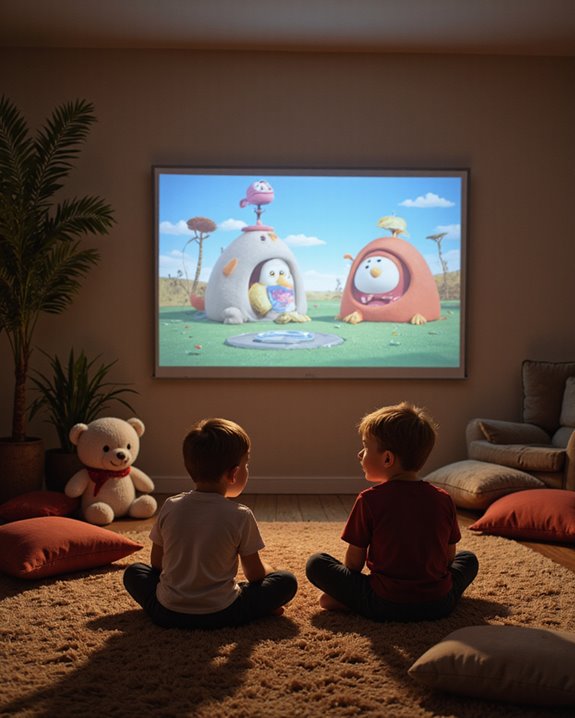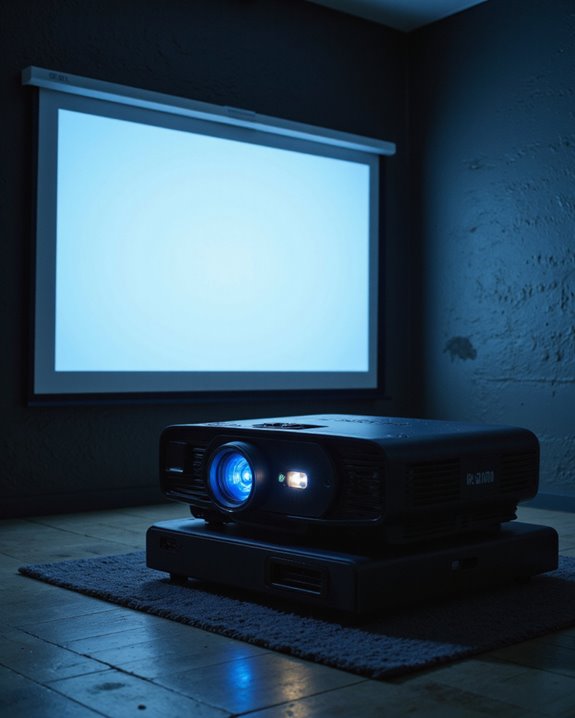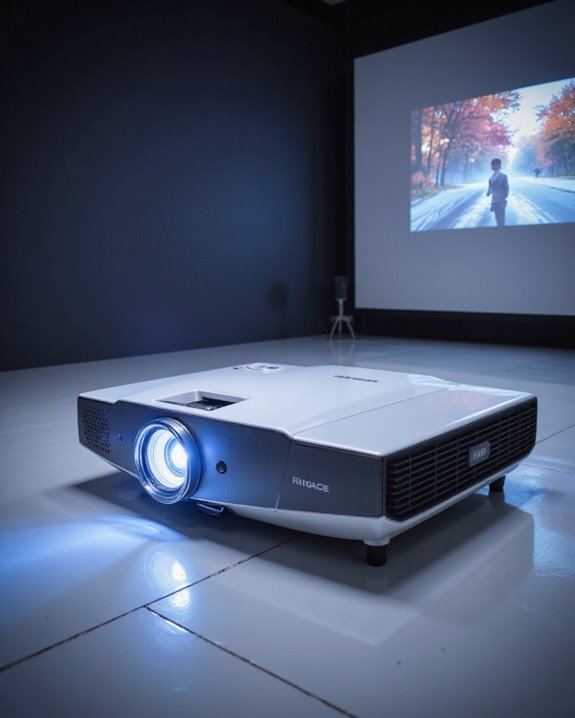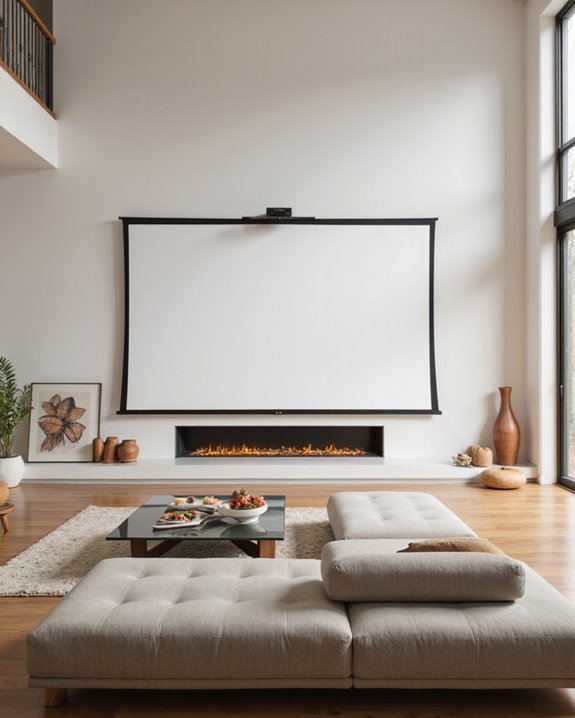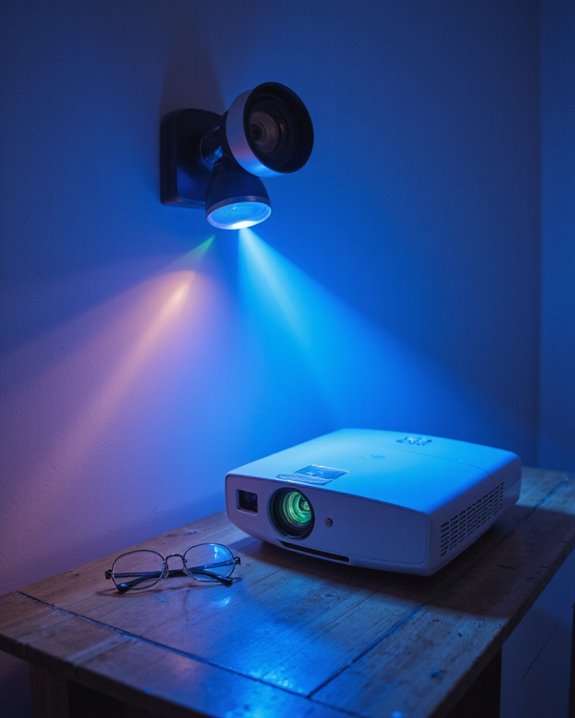Projectors offer key advantages for children’s viewing compared to traditional TVs. Their reflected light causes less eye strain and reduces harmful blue light exposure, while the larger display encourages safer viewing distances. Modern projectors include child-safety features like automatic shutoff sensors and sturdy mounting options. The gentler visual experience aligns with pediatric screen time guidelines, though proper setup and room lighting control remain important considerations. Understanding the full range of benefits and limitations helps families make informed entertainment choices.
Key Takeaways
- Projectors reduce direct blue light exposure and create diffused lighting, making them gentler on children’s developing eyes compared to traditional TVs.
- Projected images encourage safer viewing distances and better posture, as children naturally position themselves farther from the light source.
- Setup and maintenance requirements, including room darkening and regular bulb replacement, make projectors less practical for everyday kids’ viewing.
- Projectors support larger viewing areas for group activities and educational content, enhancing collaborative learning experiences among children.
- Modern TVs offer consistent brightness and clearer images in lit rooms, making them more reliable for regular viewing despite higher blue light exposure.
The Science Behind Projector Light Vs TV Screen Light
Two fundamental technologies shape how we view television content: projectors and TV screens, each operating on distinct principles of light emission and display. The key difference lies in how light reaches viewers’ eyes: projectors reflect light off a screen at a projection angle, while TVs emit light directly toward the viewer. TV screens maintain consistent brightness and color accuracy regardless of room lighting, using advanced technologies like OLED (Organic Light-Emitting Diodes) that produce their own light. Projectors, however, rely on external light sources that must travel through the light color spectrum before reaching a reflective surface. This makes them more susceptible to ambient light interference, potentially affecting image quality. The projection method requires careful consideration of room conditions, screen quality, and positioning to achieve best viewing results, especially for extended viewing sessions. Modern TVs like the U7 QLED can reach 767.7 nits of brightness with a 25% window, making them significantly more visible in well-lit environments. Additionally, the ambient light in a room can greatly influence the viewer’s ability to see clear, vibrant images on a projector compared to a TV.
Eye Health Benefits of Projector Viewing for Children
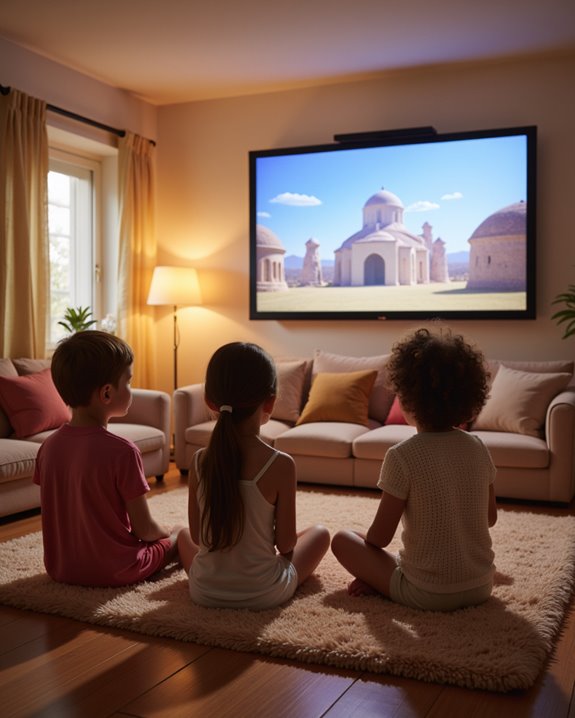
When considering children’s eye health, projectors offer significant advantages over traditional TV screens and digital devices. The diffused lighting technology in projectors reduces direct exposure to harmful blue light, creating a gentler viewing experience that supports developing vision. While color accuracy remains excellent in modern projectors, the softer visual effect helps prevent eye strain and fatigue. Additionally, many modern projectors incorporate blue light reduction features that further protect children’s eyes during extended viewing sessions. Research indicates that projected images are particularly beneficial for children’s sensitive eyes, as they reflect light rather than emit it directly. This reflection method, combined with proper sound quality and viewing distance options, creates a more natural viewing environment. The larger screen size also encourages children to maintain a safer distance from the display, reducing the risk of eye strain and potential long-term vision problems associated with close-range viewing of traditional screens. Extended exposure to conventional screens can lead to macular degeneration and other serious eye conditions over time.
Safety Features and Child-Friendly Aspects of Projectors
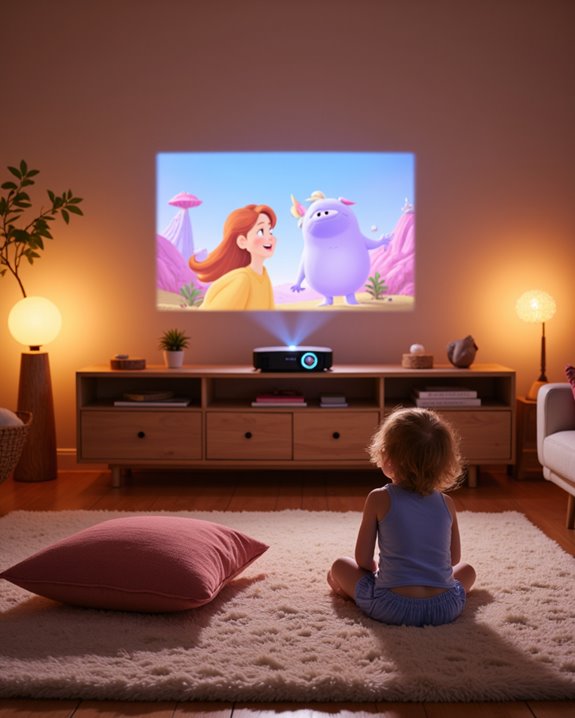
Modern projectors designed for children incorporate extensive safety features that protect both the device and its young users. Smart sensors automatically shut off the light beam when someone approaches the lens, while blue light filtering technology helps protect developing eyes. These devices also feature splash-proof and shock-resistant housing to withstand typical rough handling during use. Bright 1080p resolution delivers stunning picture quality for immersive viewing experiences. Additionally, some models utilize laser phosphor light sources that emit less heat and reduce the risk of burns, making them safer for children. Proper projector maintenance and parental supervision are enhanced through built-in controls. Parents can limit access to settings through keypad locks and remote configuration options. The devices often include child-safe mounting solutions and protective casings. Additional safety features include volume-limiting capabilities to protect hearing, low-heat LED lights to prevent burns, and sturdy construction to reduce electrical hazards. Many models also come with stable bases or tripods for secure placement.
Creating an Optimal Viewing Environment With Projectors
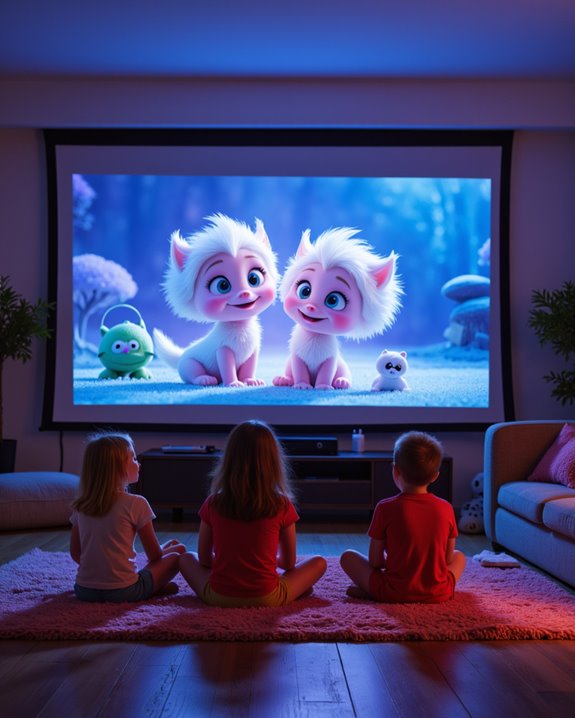
Safety features lay the groundwork for projector use, but creating the right viewing environment maximizes both enjoyment and protection for young viewers. The setup requires careful attention to room conditions and equipment placement.
Key elements for an excellent viewing space include:
- Managing ambient light through curtains or blinds to maintain screen brightness
- Positioning the projector at the correct distance for the desired projector size
- Using a proper viewing surface, such as a white wall or dedicated screen
- Organizing cables to prevent accidents
- Ensuring comfortable seating arrangements at appropriate distances
The ideal environment also considers sound quality and connectivity options. Modern projectors with built-in speakers and wireless capabilities make it easier to create an engaging setup while maintaining a clutter-free space that’s safe for children to move around in. The diffused light projection method used by these devices significantly reduces eye strain compared to direct LED screens, making them a safer choice for extended viewing sessions.
Educational Advantages of Projector-Based Learning
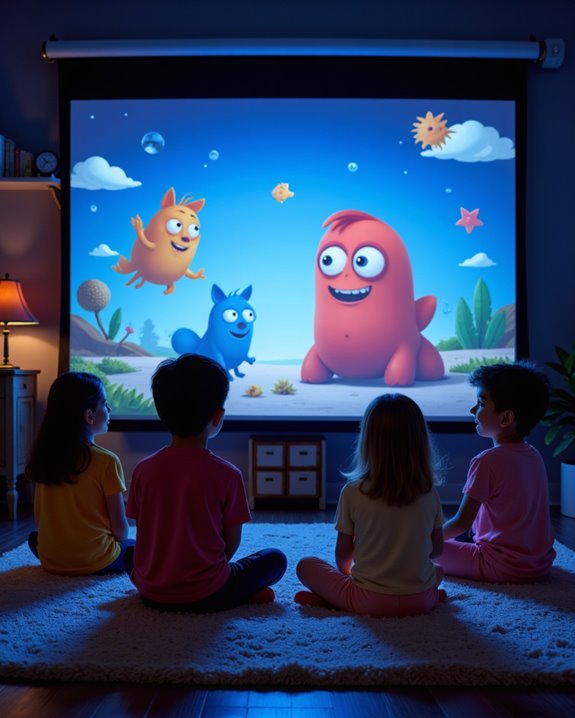
Educational projectors revolutionize the learning experience by transforming passive lessons into dynamic, interactive sessions that engage multiple senses. Through multimedia integration, students can explore complex concepts using videos, simulations, and digital resources that bring subjects to life.
Interactive engagement increases when students participate in shared digital workspaces, fostering collaboration and peer learning. Studies show that projector-based learning environments support multiple learning styles while improving academic achievement. The technology creates immersive experiences that help students retain information more effectively through visual and hands-on interaction. Research demonstrates that project-based learning consistently leads to significant gains in student achievement and engagement across various subjects and grade levels.
The versatility of projectors enables teachers to present diverse digital content, supporting differentiated instruction and real-time feedback. This technology turns students from passive observers into active contributors, encouraging participation in group discussions and collaborative problem-solving activities. The result is a more engaging and effective educational experience that promotes deeper understanding of subject matter.
Pediatric Guidelines for Screen Time and Projector Use
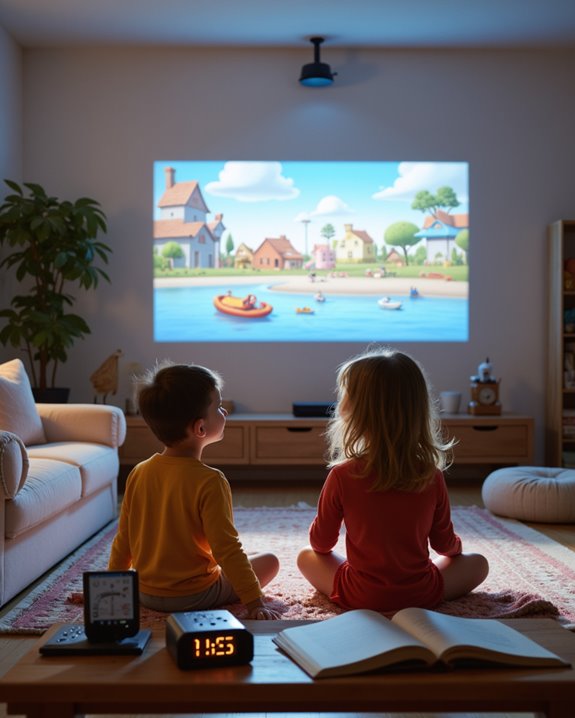
While projectors offer unique advantages for children’s viewing experiences, pediatric experts emphasize specific screen time guidelines that apply to all display technologies. For children under 18 months, no screen time is recommended except for video chatting. Children aged 2-5 should limit viewing to one hour of quality programming daily, regardless of display method.
To prevent screen addiction, parents should implement strict time limits and use parental controls across all devices, including projectors. The guidelines focus on maintaining healthy sleep patterns and physical activity levels. Today’s children spend 4-6 hours daily consuming screen media, making parental supervision crucial. For school-age children, screen time should not interfere with 9-12 hours of sleep and at least one hour of daily exercise. While projectors may reduce eye strain compared to smaller screens, the same content and duration restrictions apply to protect children’s cognitive and social development.
Setting Up Your Home Theater Space for Kids
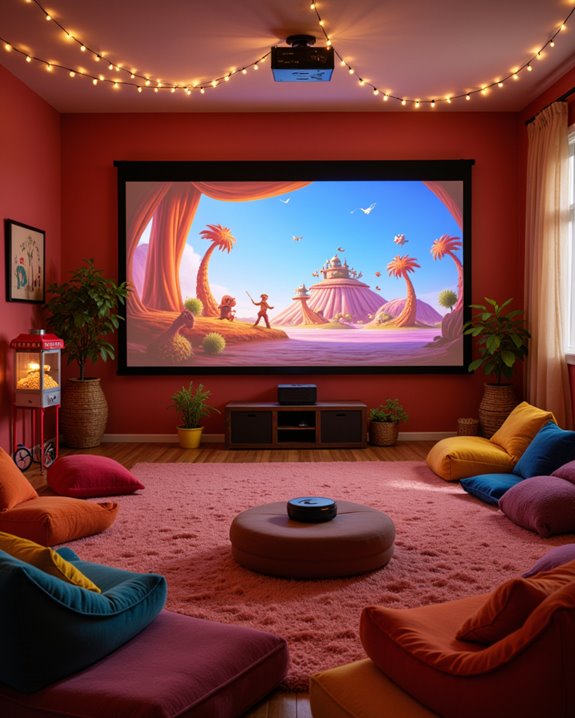
Creating a safe and engaging home theater space requires careful planning and implementation of key safety features that protect both children and equipment. Sound synchronization and color calibration settings should be secured behind childproof controls while maintaining ideal viewing quality. Retractable cinema screens provide an additional layer of protection against potential scratches and damage from children’s curious hands.
The setup should prioritize safety through strategic placement of components. Essential measures include:
- Mounting projectors in protective cages
- Installing covered power strips
- Using cable management systems to eliminate tripping hazards
- Securing all equipment with appropriate wall or floor anchors
- Creating designated viewing zones with comfortable seating
A well-designed space incorporates storage solutions that keep electronics and small parts out of children’s reach. Clear pathways and proper lighting enhance safety while allowing easy navigation. Interactive elements can be added within safe distances from equipment, making the viewing experience both secure and enjoyable for young audiences.
Managing Practical Limitations of Projector Systems
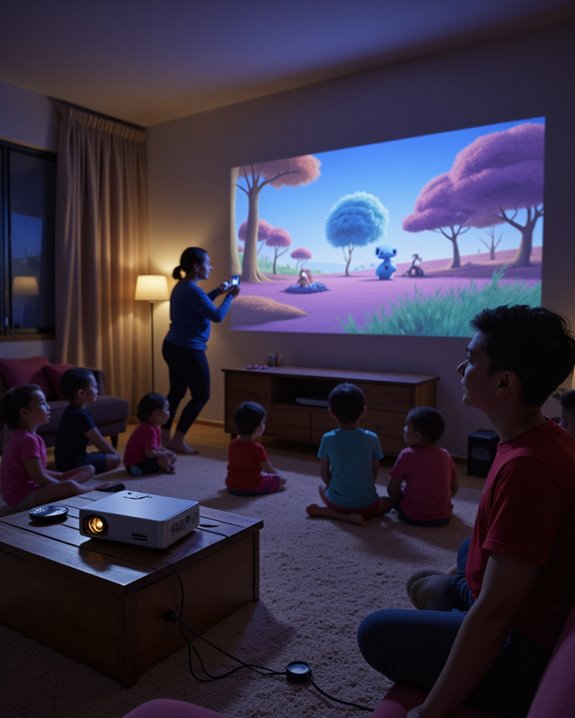
Successfully managing a projector system requires understanding and addressing several key operational limitations. Proper projector placement is vital, as these devices need specific mounting positions on either the ceiling or a low table to achieve ideal viewing angles. Regular maintenance challenges include cleaning the lens, replacing bulbs, and ensuring proper ventilation. Most affordable projectors require 2,000 lumens minimum for clear viewing on a standard 100-inch screen in darkened rooms.
Parents should consider several practical factors when using projectors for children’s viewing:
- Room lighting must be controlled to maintain image quality
- Bulb replacements can be costly and must be budgeted
- Additional equipment like speakers and mounting hardware is needed
- Setup may require rearranging furniture to accommodate viewing angles
- Regular cleaning and maintenance routines are essential
These limitations can be managed effectively with proper planning and regular system upkeep, ensuring a reliable viewing experience for children.
Long-Term Health Impacts: Projectors Vs Traditional TVS
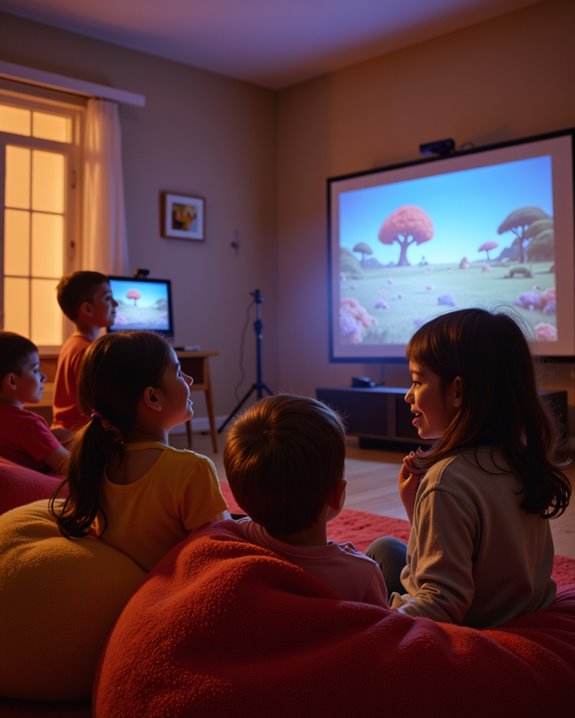
As parents consider entertainment options for their children, understanding the health impacts of projectors versus traditional TVs becomes increasingly important. Research suggests that projectors offer several advantages for children’s eye health, including reduced blue light exposure and less direct light emission. While parental controls remain essential for both viewing methods, projectors’ larger viewing distances and reduced glare can minimize eye strain.
Healthcare professionals, including pediatric nutrition experts, emphasize that any screen time should be carefully monitored regardless of the display method. The AAP recommends no TV viewing for children under age 2, making it crucial for parents to carefully consider any screen-based entertainment choices. However, projector systems may provide a gentler viewing experience compared to traditional TVs. The indirect light reflection and greater viewing distances align better with vision health guidelines, particularly for developing eyes. Parents should still maintain recommended screen time limits and ensure children engage in regular outdoor activities.
Frequently Asked Questions
Can Projector Use Damage Walls or Leave Permanent Marks Over Time?
Modern projectors do not cause direct wall damage or permanent wall marks when used properly. However, using a dedicated projection screen is recommended to protect walls and maintain ideal image quality over time.
How Often Should Projector Filters and Lenses Be Cleaned for Kids’ Safety?
Like a car needs regular oil changes, projectors require monthly filter maintenance in high-use settings and bi-monthly lens cleaning. For children’s safety, filters should be cleaned every 100-300 hours and inspected weekly for dust accumulation.
What Alternatives Exist When Projectors Malfunction During Children’s Scheduled Viewing Time?
When projectors malfunction, screen alternatives include tablets, smartphones, and laptops. Backup devices like smart TVs, portable mini projectors, or streaming sticks guarantee continuous viewing. Wall surfaces can serve as temporary projection areas.
Do Smart Projectors Require Special Internet Security Settings for Child Protection?
Just like ye olde safety locks, smart projectors require childproof internet configurations. Essential security measures include robust parental controls, firewall settings, encrypted Wi-Fi connections, and content filtering to protect young viewers from inappropriate material.
Can Multiple Projectors in Different Rooms Affect Home Wifi Performance?
Multiple projectors in different rooms can create wireless interference and increase network congestion. When streaming simultaneously, they consume significant bandwidth, potentially reducing overall WiFi performance and impacting internet speeds for all connected devices.

